Earlier, I was scrolling on LinkedIn and came across this ad.
Instantly, I was impressed with the effectiveness of the language.
The language, concise and clear, offers up the benefit of the product being marketed in a way that stops scrollers in their tracks, including me.
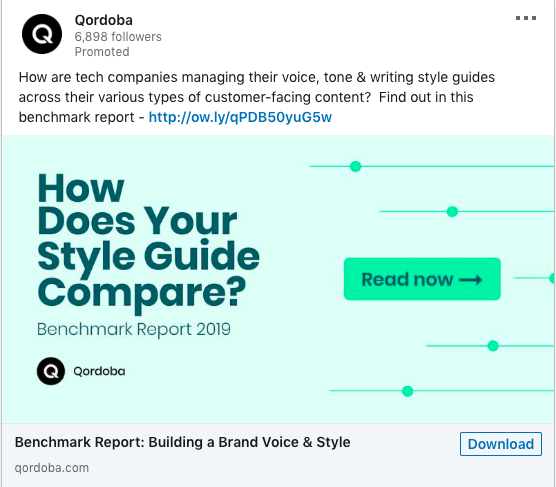
Qordoba is an IT company that helps companies stay consistent with communication through AI technology.
The company's ad caught my eye by communicating the benefits reading the report will have when it comes to customer-facing content, which does interest me.
'How are tech companies managing their voice, tone, & writing style guides across their various types of customer-facing content?'
After reading this caption, I knew exactly what I would gain from this product, and why it was worth my time.
The beauty of proper messaging is that by communicating either the benefits or features of your product or service, you can tell customers what they need to know in a clever, concise way.
As a marketer, you're likely wondering when you should use benefits versus features in your content. We've got an answer, and we're going to dive into that in the next couple of sections.
Features vs. Benefits
What exactly is a "feature" or "benefit," anyway?
Both methods are useful and give customers important information they'll need during their buyer's journey, such as design, price, and real-world relevance. Ultimately, however, the benefits of having a product or service are what make consumers purchase. If you do decide to highlight features, you'll want to make sure consumers understand how they'll benefit from those features.
Let's look at another example of features and benefits at work. This is a marketing email I got this morning from Marriott hotels:
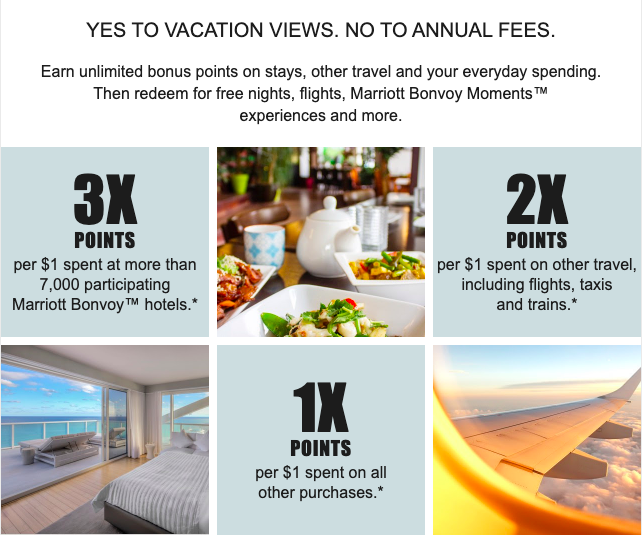 This ad starts with the benefits of becoming a Marriott member — 'yes to vacation views' — while the rest of it explains the features of the program, including 'no annual fees' and '3X points per $1 spent at more than 7,000 Marriott locations.
This ad starts with the benefits of becoming a Marriott member — 'yes to vacation views' — while the rest of it explains the features of the program, including 'no annual fees' and '3X points per $1 spent at more than 7,000 Marriott locations.
Emphasizing that Marriott members enjoy free perks, then expanding on how this is done (by earning rewards points), is a really effective way to explain the benefits and features of the rewards membership.
Which is relatively straightforward — but what if you have multiple products being sold at once?
If you're working with more than one campaign at once, remember the "Features or benefits?" the answer can change depending on the product.
If you're unsure whether you should list features or benefits for a given product, consider this — features are an optimal choice in a saturated market. For instance, a small business making a meal-delivery kit would have some competition (such as HelloFresh or Home Chef), so they would have to communicate their service's competitive advantage by naming one-of-a-kind features. This would include price, dietary restrictions, menu configuration, etc.
Benefits, on the other hand, are the way to go if your brand exists within a niche market or a "drier" topic. You'll want to answer the following questions with your benefits: How does it work? How does it make a consumer's life easier?
To resonate well with an audience who perhaps haven't heard of your product or service before, try to include benefits in your demos, ebooks, and other marketing content..
Now that we're more clear on features vs. benefits, let's explore some examples to see both in-action.
Features and benefits: Examples
For the visual learners like myself, below are some real-world examples of how to work features or benefits into ads, product pages, email, or any other marketing materials:
1. Calm
This email about an exclusive deal made me excited, which is another way highlighting features in your marketing material can be beneficial — to build excitement. Here's how sleep meditation company Calm did it:
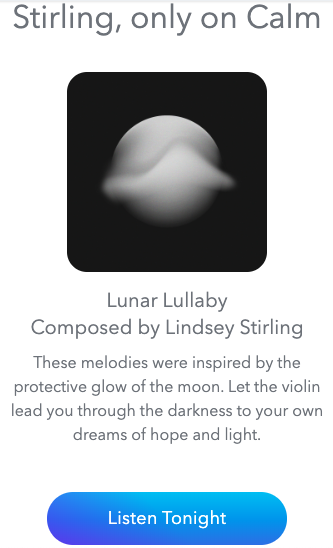 Framing singer/songwriter Lindsey Stirling's work as an exclusive feature improves customer relationships and makes them feel special. Opening this email made me think about how glad I am to be an email subscriber (especially since I grew up watching Stirling on YouTube) because of cool offers like this.
Framing singer/songwriter Lindsey Stirling's work as an exclusive feature improves customer relationships and makes them feel special. Opening this email made me think about how glad I am to be an email subscriber (especially since I grew up watching Stirling on YouTube) because of cool offers like this.
If you're running a promotion or want to improve customer relationships, consider sending them an offer that reminds customers of your product or service's unique features.
2. HubSpot Academy
In this product page for HubSpot Academy's social media course, three benefits are listed at the bottom, so prospects can see how completing this course will be worth their time:
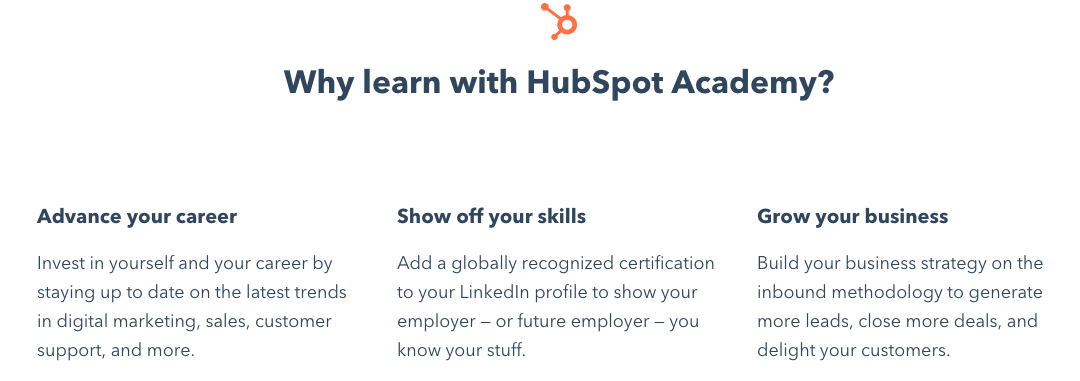
Benefits don't always have to be short phrases – in fact, on product pages, more is often better. On web pages, it's critical you give your customers the helpful information they need — including cost, structure, time required to complete, and a description on how your products or services' benefits outweigh the benefits of competitors'.
3. Arcadia
Can you spot the benefits energy company Arcadia used in this promoted tweet?
Here's the easiest way to save on your utility bill and get clean energy.
— Arcadia (@arcadia) February 18, 2020
If you chose the entire tweet, you're right!
Almost every word helps describe to the reader why they should open the linked website. As a consumer, I would think, "Well, what is the easiest way to save on my energy bill at no cost? That thing is sky high!"
Words that help the consumer are going to resonate with those who are just mindlessly scrolling and not necessarily looking to buy anything. To build interest in their promotion, Arcadia's use of benefits to entice prospective customers was a good choice on Twitter.
Impress a scroller by using benefits in marketing messages. You have a few seconds to leave a mark.
4. Airtable
Beautiful, descriptive features in this Facebook ad told me exactly what Airtable is and what their software does, despite having no previous knowledge. In less than thirty words, I know that Airtable must be a product or service that makes dull spreadsheets a thing of the past — for free.
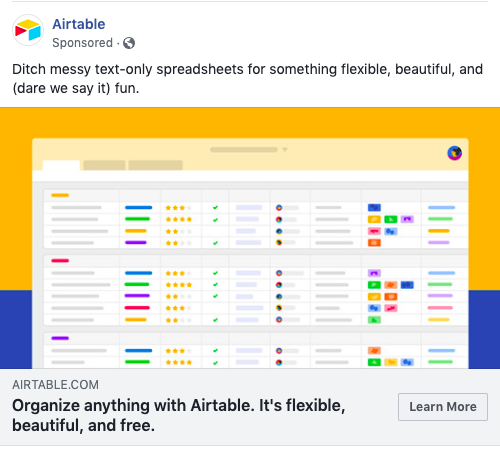
Marketing teams that don't have the budget to spend on a full suite of fancy products might come across this ad, see the features, and think "Flexible, beautiful, and fun? Spreadsheets? For free? I should look into this," and immediately hit that CTA.
Many of us use spreadsheets that are mostly text and less colorful, so Airtable does a good job detailing how they're different from Microsoft Excel or Google Sheets, and helps them seem like a game-changer to consumers.
5. KeVita
Kombucha is a fermented tea drink with probiotics, which aid in helping digestion and improving energy levels. So, when marketing their kombucha on Instagram, the KeVita brand wanted to show that kombucha isn't just a summer drink, contrary to popular belief.
Aesthetically pleasing, benefit-enforcing GIFs like this make visual platforms like Instagram a perfect canvas for an ad that displays benefits.
Animation often stops scrollers — especially animation paired with bright pink text. The backdrop, a ski lift covered in fresh snow, ("powder" to skiers), shows the accessibility of the drink, while the caption alludes to kombucha-fueled energy to get through a long ski trip.
Two benefits that instantly stuck out to me about this post are accessibility and energy. On snowy mountains, those two functions are going to be essential when thinking about snacks. Consider a scenario-based ad if your product is like KeVita, commonly perceived as a summer drink.
From phones to shampoo, , the features/benefits marketing method can be applied to almost anything. As we saw, it's important to know the distinction so audience members can deliver a clear marketing message.
Asking yourself, "Does this ad convey features or benefits?" and structuring accordingly is a simple thought to consider when creating copy that could improve the interpretation of product pages or ads by the public. What do you want to say, and which messaging method will be best for that?
from Marketing https://ift.tt/2troQ2h

No comments:
Post a Comment